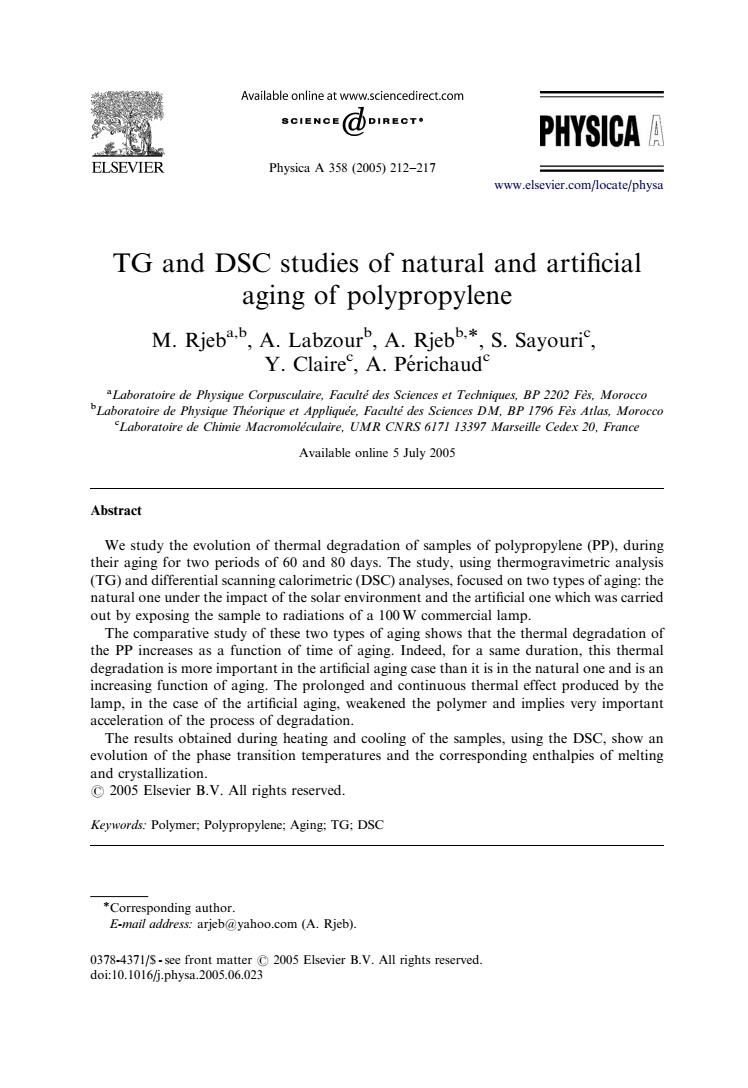正在加载图片...

Available online at www.sciencedirect.com PHYSICA A ELSEVIER Physica A358(200)212-217 www.elsevier.com/locate/physa TG and DSC studies of natural and artificial aging of polypropylene M.RjebA.LabzourA.RjebS.Sayouri Y.Claire,A.Perichaud Laboratoire de Chimle Macromolecaire.UMR CNRS6171 13397 Marselle Cedex20.Framce Available online 5 July 2005 Abstract natural one under the impact of the solar environment and the artificial one which was carie out by exposing the sample o radiations of a 100 W commerc degradation is more important in the artificial aging case than it is in the natural one and is an reasing tunction of aging.I prolonged and continu us therm d by th odpou evolution unn heating and coong of the samples.using the ho of the phase transition temperatures and the corresponding enthalpies of melting 2005 Elsevier B.V.All rights reserved. Keywrd:Polymer:Polypropylene:Aging:TG:DSC Coremponding athor. @yahoo.com(A.Rjeb)Physica A 358 (2005) 212–217 TG and DSC studies of naturaland artificial aging of polypropylene M. Rjeba,b, A. Labzourb , A. Rjebb,, S. Sayouric , Y. Clairec , A. Pe´richaudc a Laboratoire de Physique Corpusculaire, Faculte´ des Sciences et Techniques, BP 2202 Fe`s, Morocco b Laboratoire de Physique The´orique et Applique´e, Faculte´ des Sciences DM, BP 1796 Fe`s Atlas, Morocco c Laboratoire de Chimie Macromole´culaire, UMR CNRS 6171 13397 Marseille Cedex 20, France Available online 5 July 2005 Abstract We study the evolution of thermal degradation of samples of polypropylene (PP), during their aging for two periods of 60 and 80 days. The study, using thermogravimetric analysis (TG) and differential scanning calorimetric (DSC) analyses, focused on two types of aging: the naturalone under the impact of the solar environment and the artificialone which was carried out by exposing the sample to radiations of a 100 W commercial lamp. The comparative study of these two types of aging shows that the thermaldegradation of the PP increases as a function of time of aging. Indeed, for a same duration, this thermal degradation is more important in the artificialaging case than it is in the naturalone and is an increasing function of aging. The prolonged and continuous thermal effect produced by the lamp, in the case of the artificial aging, weakened the polymer and implies very important acceleration of the process of degradation. The results obtained during heating and cooling of the samples, using the DSC, show an evolution of the phase transition temperatures and the corresponding enthalpies of melting and crystallization. r 2005 Elsevier B.V. All rights reserved. Keywords: Polymer; Polypropylene; Aging; TG; DSC ARTICLE IN PRESS www.elsevier.com/locate/physa 0378-4371/$ - see front matter r 2005 Elsevier B.V. All rights reserved. doi:10.1016/j.physa.2005.06.023 Corresponding author. E-mail address: arjeb@yahoo.com (A. Rjeb)